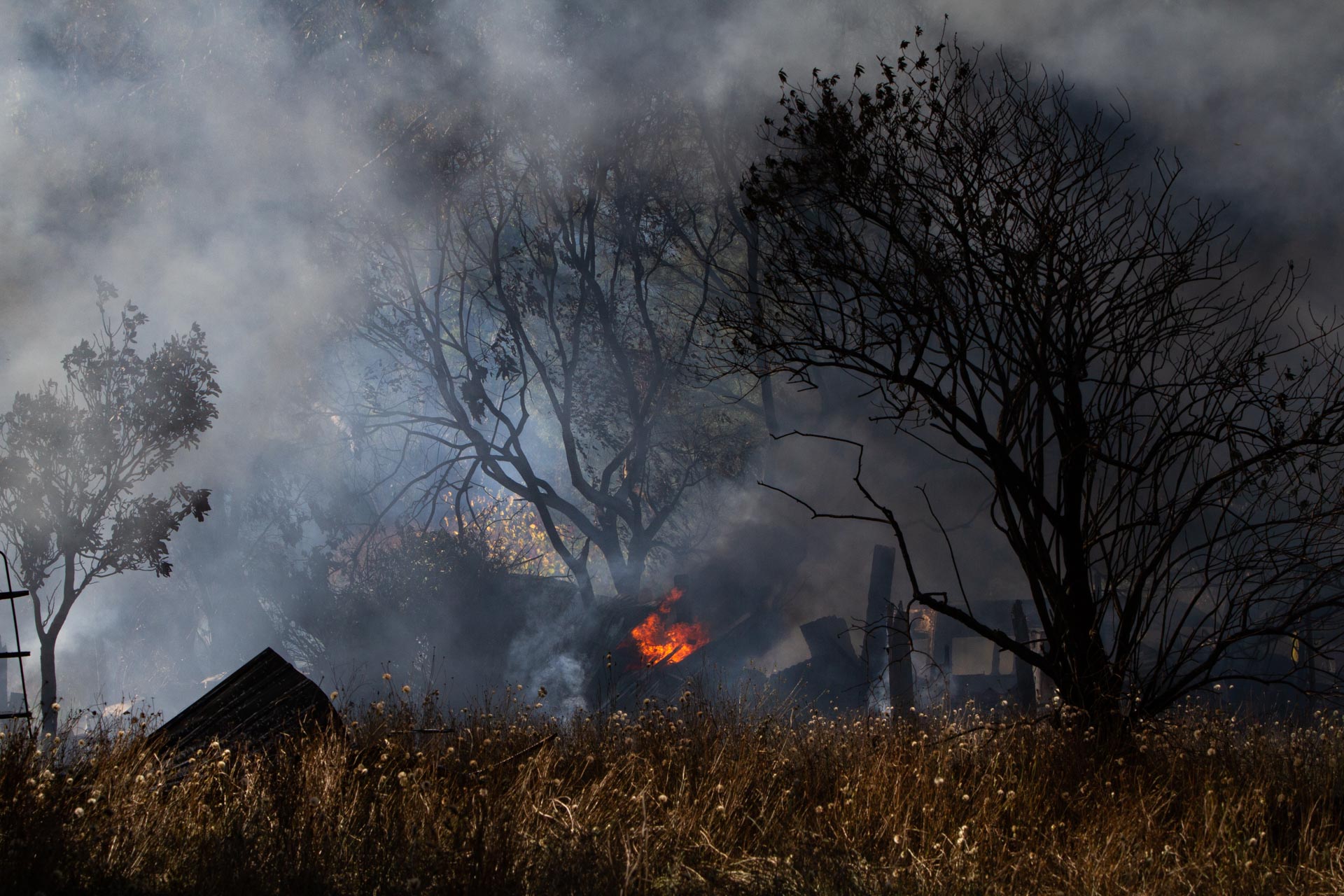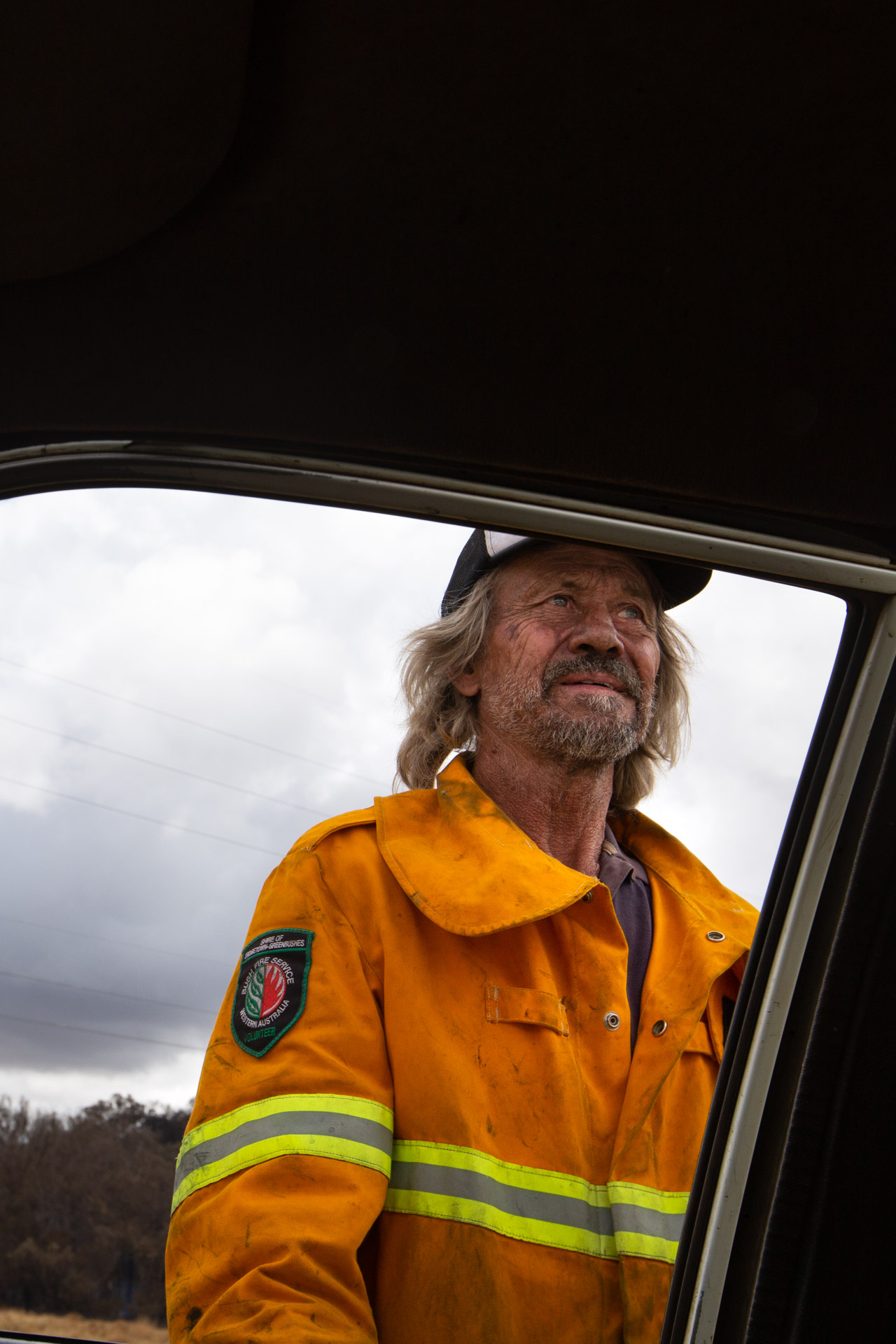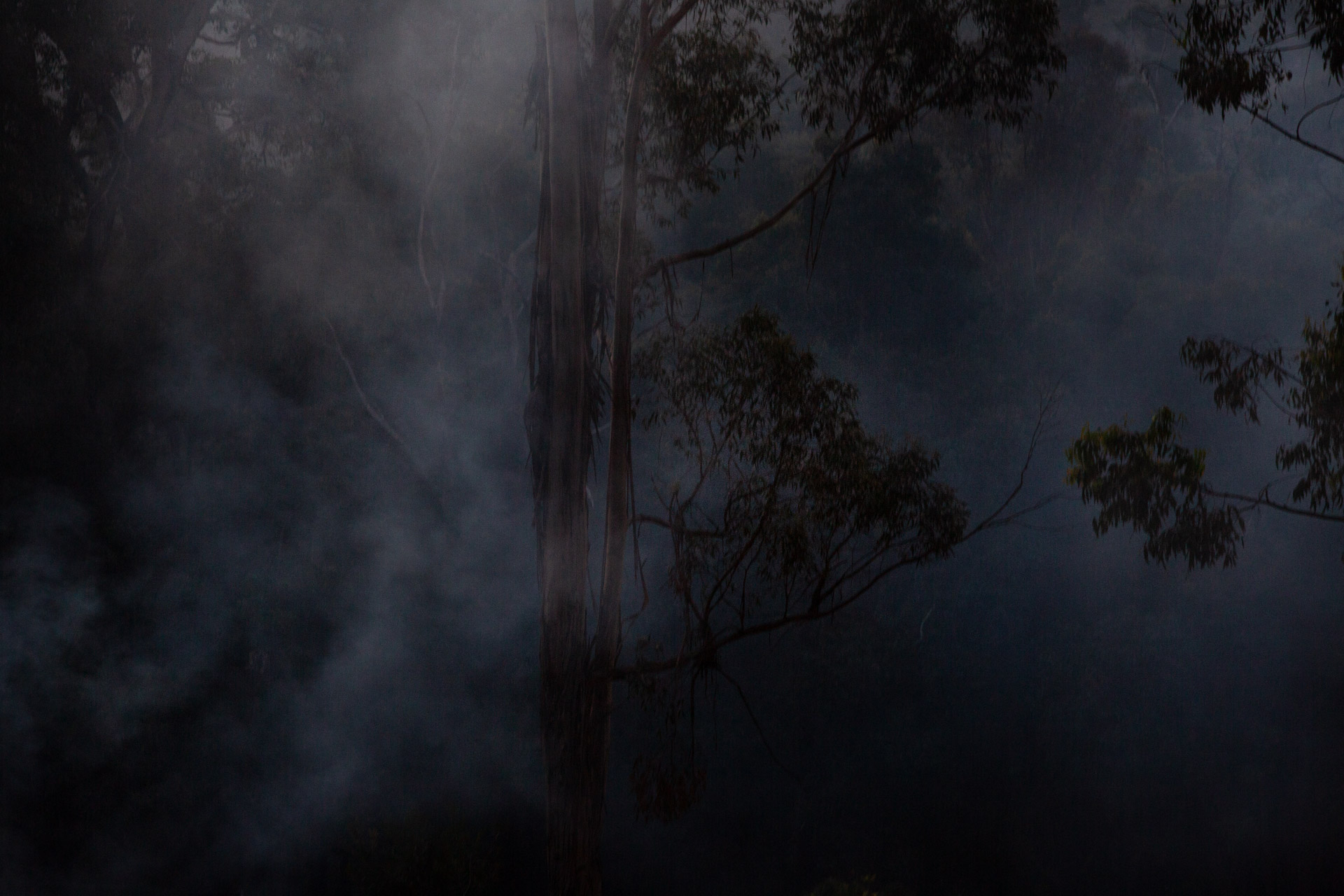The Defenders
‘The Defenders’ is a joint project by photographers Victoria Baker and Davina Jogi, which juxtaposes formal portraits of the local Bush Fire Brigade volunteers with elements of their natural environment in the southwest Shire of Bridgetown-Greenbushes.
Imagined as a response to the cataclysmic 2019 Australian bushfire season, the series combines formal portraiture and documentary work. These are not the typical images of crisis that characterize bushfire reportage but of day-to-day realities. The work draws on Janet Roitman’s concept of “anti-crisis” – what are the stakes of crisis? If crisis entails reference to a norm, what is the norm for people who chose to accept the annual threat of bushfire to their lives and homes?
‘The Defenders’ presents an insider perspective of WA’s unique voluntary bushfire service as it faces the increased challenges of a lengthening fire season and an ageing volunteer base. The intention is to highlight the unseen, ordinary people whose livelihoods, families, and history are as invested in the Australian bush as they are devastated by it.
The project was supported through a 2021 Resilience Grant from Regional Arts WA which funded a 3-month mentorship with award-winning, Australian photographic artist Aletheia Casey to assist in developing the work.
 Craig White (right), Fire Captain of the Hester Brook Volunteer Bush Fire Brigade, leads a training exercise in map reading with members of various local brigades at Four Seasons Estate in Bridgetown, Western Australia in November 2020 at the start of summer. One of the key challenges identified by the Department of Fire and Emergency Services’ (DFES) Sustainability Strategy is its aging volunteer base and the difficulties this presents for succession planning.
Craig White (right), Fire Captain of the Hester Brook Volunteer Bush Fire Brigade, leads a training exercise in map reading with members of various local brigades at Four Seasons Estate in Bridgetown, Western Australia in November 2020 at the start of summer. One of the key challenges identified by the Department of Fire and Emergency Services’ (DFES) Sustainability Strategy is its aging volunteer base and the difficulties this presents for succession planning.
 A tree spouts embers during a bushfire near Yovanche Road, Catterick on January 8, 2021. The fire was contained relatively quickly after aerial water bombers were called in to assist ground crews, but the ‘mop up’ operation, during which BFBs put out burning logs and burning trees, lasted into the night and next day. Many volunteers recount stories of fires starting up again from roots burning underground or fires ‘hopping over’ breaks from the tops of trees.
A tree spouts embers during a bushfire near Yovanche Road, Catterick on January 8, 2021. The fire was contained relatively quickly after aerial water bombers were called in to assist ground crews, but the ‘mop up’ operation, during which BFBs put out burning logs and burning trees, lasted into the night and next day. Many volunteers recount stories of fires starting up again from roots burning underground or fires ‘hopping over’ breaks from the tops of trees.
 At the same fire, Jim Eastcott, a member of Catterick BFB, is pictured in his converted Ford ute which carries a tank and pump for bushfire suppression, as well as, his wheelchair. With over 40 years of experience, Jim and his wife, Claire, are often the first responders to a bushfire in their area. Jim does the navigating and driving, while Claire hoses. “You’ve gotta trust your instinct up to a point,” he says, “if the hairs on the back of your neck start to stand up too much, well, you’ve just got to go.”
At the same fire, Jim Eastcott, a member of Catterick BFB, is pictured in his converted Ford ute which carries a tank and pump for bushfire suppression, as well as, his wheelchair. With over 40 years of experience, Jim and his wife, Claire, are often the first responders to a bushfire in their area. Jim does the navigating and driving, while Claire hoses. “You’ve gotta trust your instinct up to a point,” he says, “if the hairs on the back of your neck start to stand up too much, well, you’ve just got to go.”
 Peter and Lynnette Whitney, members of Wandillup BFB, move cattle into the yards on their property just south of Bridgetown. In December 2003, their farm was threatened by a bushfire sparked by a power line fault before a change in the wind allowed firefighters to gain control of the blaze. Lyn, who grew up on the farm next door says, “we are really quite connected to the land… there are some magic spots,” but they have both witnessed native animal behaviour changing as the weather becomes more unpredictable and their land dries out.
Peter and Lynnette Whitney, members of Wandillup BFB, move cattle into the yards on their property just south of Bridgetown. In December 2003, their farm was threatened by a bushfire sparked by a power line fault before a change in the wind allowed firefighters to gain control of the blaze. Lyn, who grew up on the farm next door says, “we are really quite connected to the land… there are some magic spots,” but they have both witnessed native animal behaviour changing as the weather becomes more unpredictable and their land dries out.
 Colin ‘Wombat’ Grant is pictured with some of his goats on his property southwest of Bridgetown. Wombat, a member of the Wandillup BFB, has lived in and around Bridgetown most of his life and speaks not only of changing rain patterns but changes in the bush itself which he sees as negatively affecting the intensity of bushfires.
Colin ‘Wombat’ Grant is pictured with some of his goats on his property southwest of Bridgetown. Wombat, a member of the Wandillup BFB, has lived in and around Bridgetown most of his life and speaks not only of changing rain patterns but changes in the bush itself which he sees as negatively affecting the intensity of bushfires.
 Initially reported as a scrub fire, a blaze quickly destroyed a Bridgetown property towards the end of the fire season in April, 2021. Residents are responsible for maintaining their own firebreaks and managing bush and dry grass around homesteads, and as one volunteer explained, “every man and his dog,” will turn out to help a neighbour during a bushfire.
Initially reported as a scrub fire, a blaze quickly destroyed a Bridgetown property towards the end of the fire season in April, 2021. Residents are responsible for maintaining their own firebreaks and managing bush and dry grass around homesteads, and as one volunteer explained, “every man and his dog,” will turn out to help a neighbour during a bushfire.
 Sietske Noble, a farrier from the Netherlands, joined the local BFB to educate herself about bushfire safety when she bought her property to agist horses in Yornup.
Sietske Noble, a farrier from the Netherlands, joined the local BFB to educate herself about bushfire safety when she bought her property to agist horses in Yornup.
 A view of the bush from Sietske's farmhouse. Like most rural Australians, she is pragmatic about living with the risk of fire, “I think you just accept what it is and do the best you can and have a plan for when the fire is close.”
A view of the bush from Sietske's farmhouse. Like most rural Australians, she is pragmatic about living with the risk of fire, “I think you just accept what it is and do the best you can and have a plan for when the fire is close.”
 Michael and Susanne Woodall pose for a portrait with their children, Shenae, Leah and Chelsea (l-r), on the street outside their house in Greenbushes. Susanne says that although she trusts that Michael has the experience and training to deal with the fires he is called out to, “now the kids are getting older, they tend to worry, so you’ve just gotta reassure them that it’s ok.”
Michael and Susanne Woodall pose for a portrait with their children, Shenae, Leah and Chelsea (l-r), on the street outside their house in Greenbushes. Susanne says that although she trusts that Michael has the experience and training to deal with the fires he is called out to, “now the kids are getting older, they tend to worry, so you’ve just gotta reassure them that it’s ok.”
 On February 5, 2022, Bridgetown and surrounds came under serious threat when a fire was sparked by a downed electricity line. Temperatures over 40°C, high winds and Bridgetown’s hilly terrain all contributed to difficult and unpredictable fire behavior.
On February 5, 2022, Bridgetown and surrounds came under serious threat when a fire was sparked by a downed electricity line. Temperatures over 40°C, high winds and Bridgetown’s hilly terrain all contributed to difficult and unpredictable fire behavior.
 Robbie Moyes, Wandillup Brigade Fire Control Officer, surveys the burnt fire ground near Krsuls Rd, Bridgetown looking for signs of smoldering ash that could be picked up by wind and cause new fires. Three days after it was extinguished, the ground was still so hot it was causing the grass to catch alight. Robbie called in a dozer to create a mineral earth break between the burnt ground and grassed paddocks.
Robbie Moyes, Wandillup Brigade Fire Control Officer, surveys the burnt fire ground near Krsuls Rd, Bridgetown looking for signs of smoldering ash that could be picked up by wind and cause new fires. Three days after it was extinguished, the ground was still so hot it was causing the grass to catch alight. Robbie called in a dozer to create a mineral earth break between the burnt ground and grassed paddocks.
 A burn-off sends smoke into the gum trees on a private property in May, 2021. Fire Control Officers, like Robbie Moyes, are responsible for overseeing bush fire management in their local areas - keeping an eye on property management, issuing permits for burning and coordinating and responding to bushfire call-outs.
A burn-off sends smoke into the gum trees on a private property in May, 2021. Fire Control Officers, like Robbie Moyes, are responsible for overseeing bush fire management in their local areas - keeping an eye on property management, issuing permits for burning and coordinating and responding to bushfire call-outs.
 Hester Brook Fire Control Officer, Keith Clothier is pictured at Maslin Reserve in Bridgetown after the BFB conducted a burn-off in autumn, 2021. Fire management plans for public spaces may be coordinated by the Department of Parks and Wildlife, the Department of Fire and Emergency Services or local government Shires, depending on who manages the land. Regardless of who conducts them, burn-offs like this one, remain controversial and often raise the ire of residents who fear the loss of flora and fauna.
Hester Brook Fire Control Officer, Keith Clothier is pictured at Maslin Reserve in Bridgetown after the BFB conducted a burn-off in autumn, 2021. Fire management plans for public spaces may be coordinated by the Department of Parks and Wildlife, the Department of Fire and Emergency Services or local government Shires, depending on who manages the land. Regardless of who conducts them, burn-offs like this one, remain controversial and often raise the ire of residents who fear the loss of flora and fauna.
 Scene during a mop-up at a bushfire in Donnelly Well reserve, Yornup, on 24 February 2021. According to DFES’s Firefighting Learner’s Manual notes, “The impact of intense fire on trees weakens both trunks and limbs. Limb failure or total tree collapse may occur well after the passing of the fire front.” Seventeen years before this photo was taken, a member of Yornup BFB was killed during a similar operation when a tree, weakened by fire, fell unexpectedly crushing him to death.
Scene during a mop-up at a bushfire in Donnelly Well reserve, Yornup, on 24 February 2021. According to DFES’s Firefighting Learner’s Manual notes, “The impact of intense fire on trees weakens both trunks and limbs. Limb failure or total tree collapse may occur well after the passing of the fire front.” Seventeen years before this photo was taken, a member of Yornup BFB was killed during a similar operation when a tree, weakened by fire, fell unexpectedly crushing him to death.
 Erin Boyle, holds her daughter, Brodie at a training session for Hester Brook Volunteer BFB. Like many rural residents, volunteering is a family affair - Erin manages Hester Brook's communications, radio and call-outs, while her husband Craig, is a lieutenant in the brigade, and Brodie is growing up with first hand knowledge of bushfires and their impact on their close-knit community.
Erin Boyle, holds her daughter, Brodie at a training session for Hester Brook Volunteer BFB. Like many rural residents, volunteering is a family affair - Erin manages Hester Brook's communications, radio and call-outs, while her husband Craig, is a lieutenant in the brigade, and Brodie is growing up with first hand knowledge of bushfires and their impact on their close-knit community.